Table of Contents
- Introduction
- Editor’s Choice
- Canned Seafood Market Overview
- Global Fisheries and Aquaculture Production
- Global Fish and Seafood Consumption Statistics
- Nutrients Found in Canned Seafood Statistics
- Types of Canned Seafood Products Consumed Statistics
- Canned Seafood Incorporated in the Diet Statistics
- Reasons to Consumer Canned Seafood Statistics
- Consumer Preferences and Trends for Canned Seafood Statistics
- Storage Conditions for Canned Seafood Statistics
- Regulations for Canned Seafood Statistics
- Recent Developments
- Conclusion
- FAQs
Introduction
Canned Seafood Statistics: Canned seafood offers a convenient and nutritious solution for consumers seeking quick and versatile meal options.
It includes varieties like tuna, salmon, sardines, anchovies, and shellfish, providing a rich source of protein, omega-3 fatty acids, and essential vitamins and minerals.
With a long shelf life of up to several years and minimal preparation required. Canned seafood is ideal for busy lifestyles.
Many brands prioritize sustainability and quality, offering eco-friendly packaging and adhering to rigorous standards throughout the canning process.
While consumers should be mindful of sodium content, innovations such as easy-open lids and single-serve pouches cater to modern preferences for convenience and sustainability. Making canned seafood a popular choice for health-conscious individuals on the go.
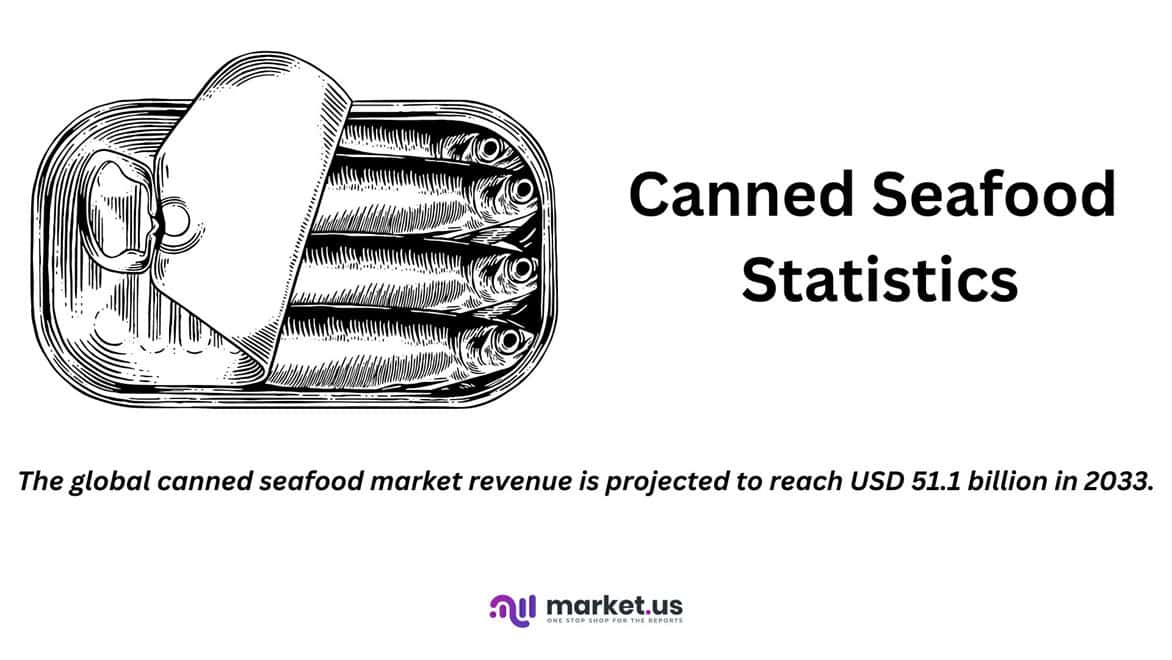
Editor’s Choice
- The global canned seafood market revenue will reach USD 51.1 billion in 2033.
- In the global canned seafood market, the distribution channels are predominantly divided between retail and food services. Retail channels hold a significant majority share, accounting for 58.30% of the market.
- The global canned seafood market is characterized by several key players, each holding varying market shares. StarKist Co. leads the market with a 14% share.
- The Asia-Pacific (APAC) region dominates with a substantial 46.5% share. Reflecting the high demand and consumption patterns in countries such as China, Japan, and Southeast Asia.
- China consumes 57,475 tonnes of fish and seafood annually, reflecting its high demand and population size.
- In assessing the relative importance of various attributes of canned tuna, consumer preferences reveal a balanced prioritization among several factors. Packaging form emerges as the most significant attribute, with 25.49% of respondents indicating its importance.
- A typical serving of canned sardines provides about 15 grams of protein, 229 milligrams of calcium, and significant amounts of vitamins such as B12, D, and E.
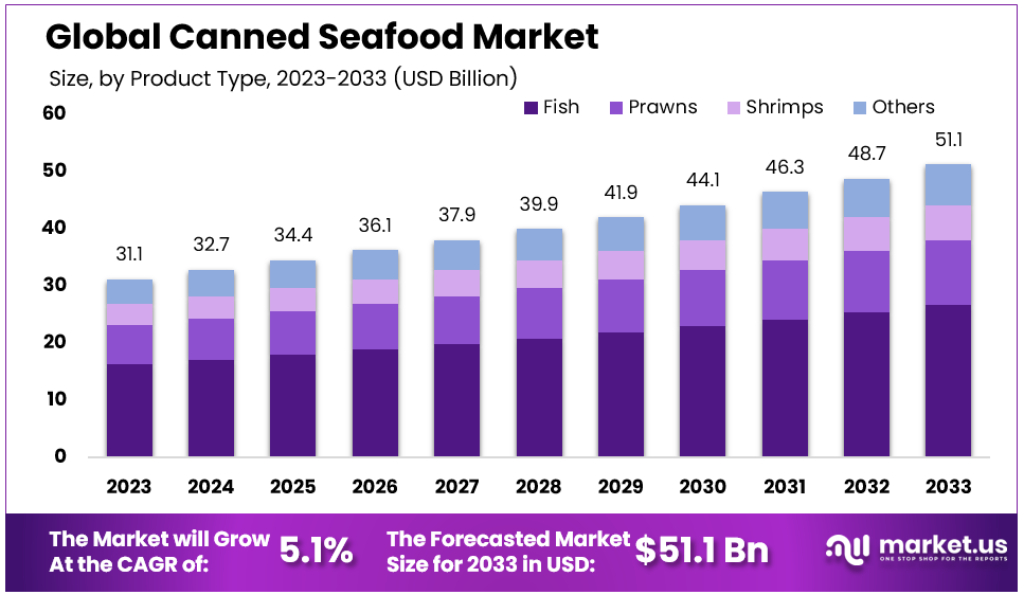
Canned Seafood Market Overview
Global Canned Seafood Market Size Statistics
- The global canned seafood market has consistently grown over the years at a CAGR of 5.1%. With revenue figures indicating a steady upward trend.
- In 2023, the market revenue was valued at USD 31.1 billion, which increased to USD 32.7 billion in 2024.
- This growth trajectory is expected to continue, with revenues projected to reach USD 34.4 billion in 2025 and USD 36.1 billion in 2026.
- By 2027, the market is anticipated to generate USD 37.9 billion, further escalating to USD 39.9 billion in 2028.
- The upward momentum is projected to persist, with the market forecasted to achieve USD 41.9 billion by 2029 and USD 44.1 billion by 2030.
- By 2031, the revenue is expected to reach USD 46.3 billion, ultimately culminating in a market value of USD 48.7 billion in 2032 and USD 51.1 billion in 2033.
- This consistent growth underscores the increasing demand and consumption of canned seafood globally.
(Source: market.us)
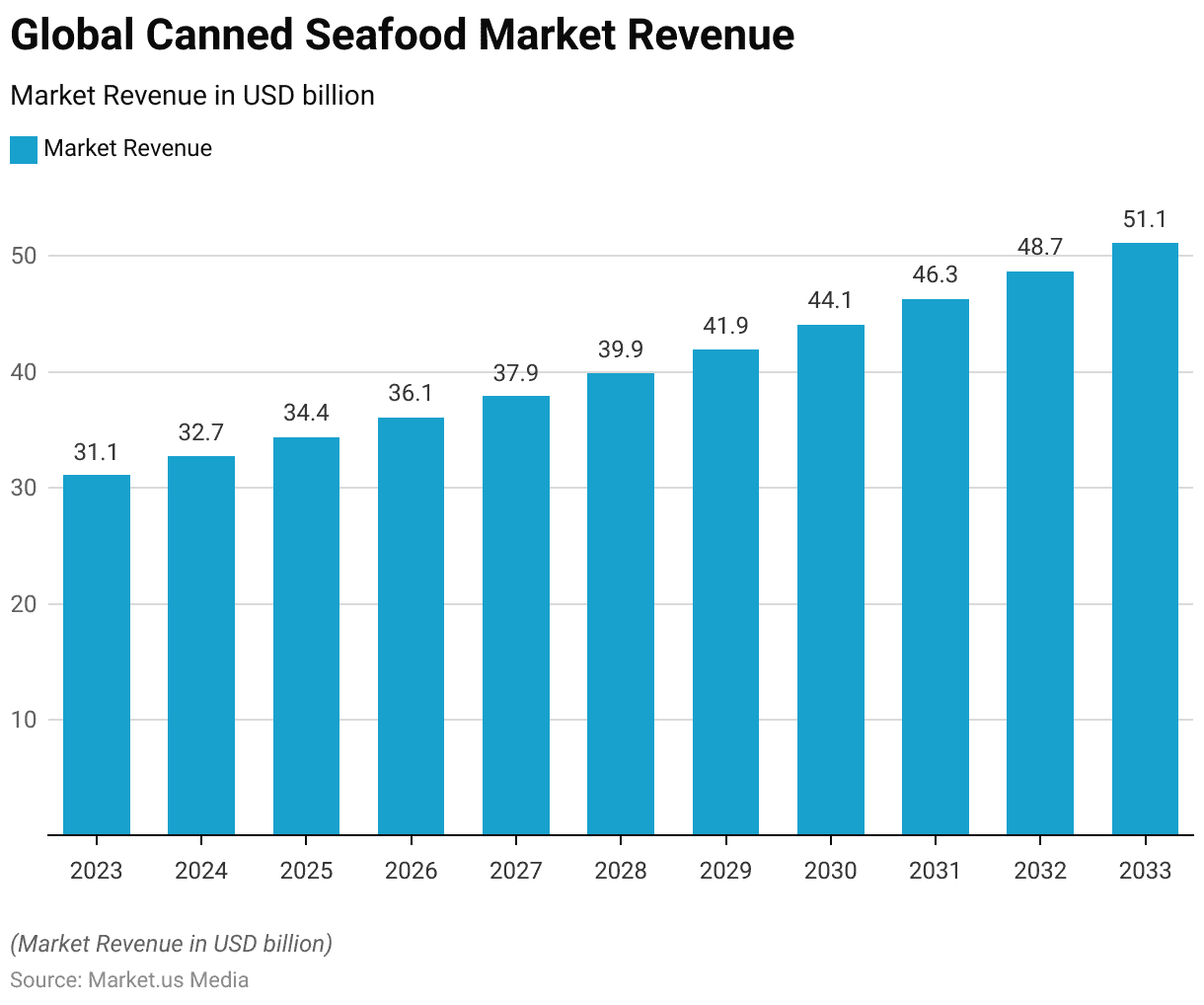
Global Canned Seafood Market Share – By Distribution Channel Statistics
- In the global canned seafood market, the distribution channels are predominantly divided between retail and food services.
- Retail channels hold a significant majority share, accounting for 58.30% of the market.
- This dominance indicates a strong consumer preference for purchasing canned seafood through retail outlets, including supermarkets, hypermarkets, and online stores.
- On the other hand, food services channels, which encompass restaurants, cafes, and catering services, constitute 41.70% of the market share.
- This distribution highlights the substantial role of both retail and food service in meeting the diverse demands of consumers for canned seafood products.
(Source: market.us)
Take advantage of our unbeatable offer - buy now!

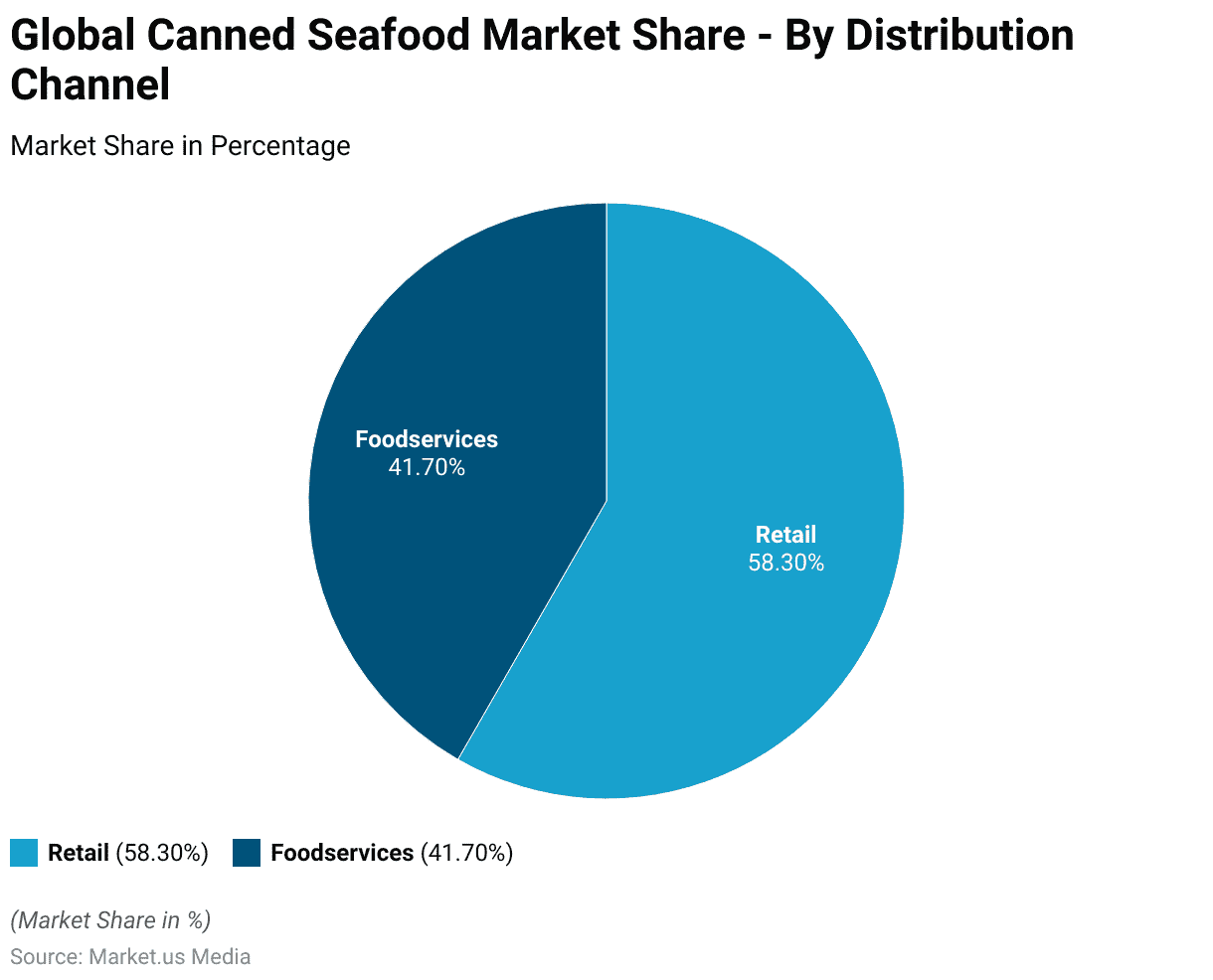
Competitive Landscape of the Global Seafood Market
- The global canned seafood market is characterized by several key players, each holding varying market shares.
- StarKist Co. leads the market with a 14% share, closely followed by Nippon Suisan Kaisha, Ltd, and Icicle Seafoods Inc., each capturing 12% of the market.
- Maruha Nichiro Corporation holds an 11% share, while LDH (La Doria) Ltd accounts for 10%.
- Wild Planet Foods commands 9% of the market, and Thai Union Frozen Products holds an 8% share.
- American Tuna, Inc. represents 7% of the market.
- Collectively, other key players contribute to the remaining 17% of the market share, highlighting a competitive and diverse industry landscape.
(Source: market.us)
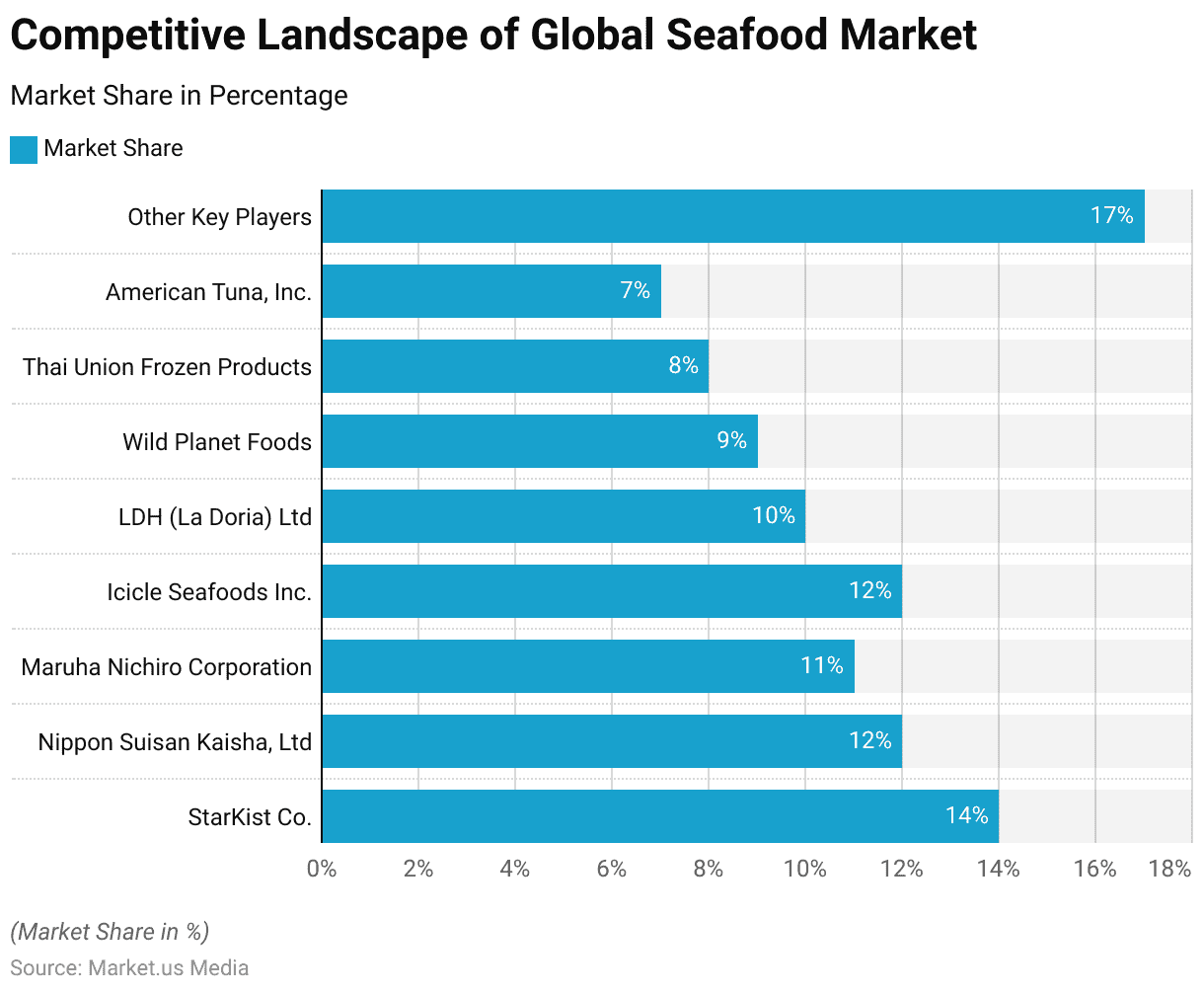
Regional Analysis of the Global Seafood Market
- The global canned seafood market exhibits significant regional variations in market share.
- The Asia-Pacific (APAC) region dominates with a substantial 46.5% share, reflecting the high demand and consumption patterns in countries such as China, Japan, and Southeast Asia.
- North America holds the second-largest market share at 27.0%, driven by strong consumer preferences and a well-established retail infrastructure.
- Europe follows with an 18.0% share, indicating a robust market presence in countries like Spain, Italy, and the United Kingdom.
- South America accounts for 6.0% of the market, while the Middle East and Africa (MEA) region holds the smallest share at 2.5%.
- These regional market shares highlight the diverse and globally distributed demand for canned seafood products.
(Source: market.us)
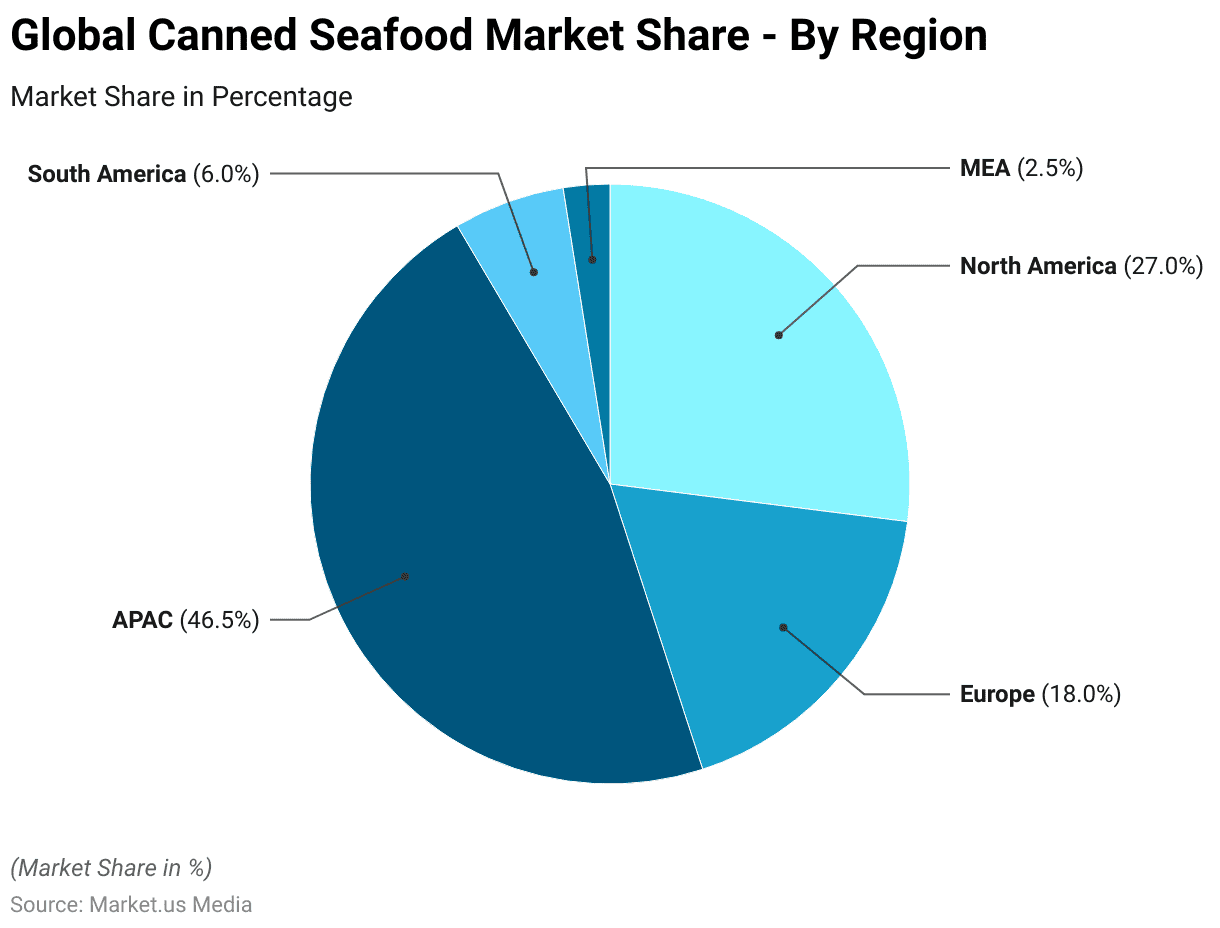
Global Fisheries and Aquaculture Production
- Global fisheries and aquaculture production has experienced notable growth over the past decades, measured in a million tonnes-live weight equivalent.
- In 1990, the production stood at 110.7 million tonnes, increasing to 134.3 million tonnes by 2000.
- This upward trend continued into 2010, with production reaching 162.6 million tonnes.
- By 2018, global production had further escalated to 178.9 million tonnes.
- However, a slight decline was observed in 2019, with production marginally decreasing to 177.4 million tonnes.
- In 2020, the production experienced a slight rebound, increasing to 177.8 million tonnes.
- These figures illustrate the overall growth and slight fluctuations in global fisheries and aquaculture production over the years, reflecting changes in demand, technological advancements, and environmental factors affecting the industry.
(Source: Food and Agriculture Organization (FAO))
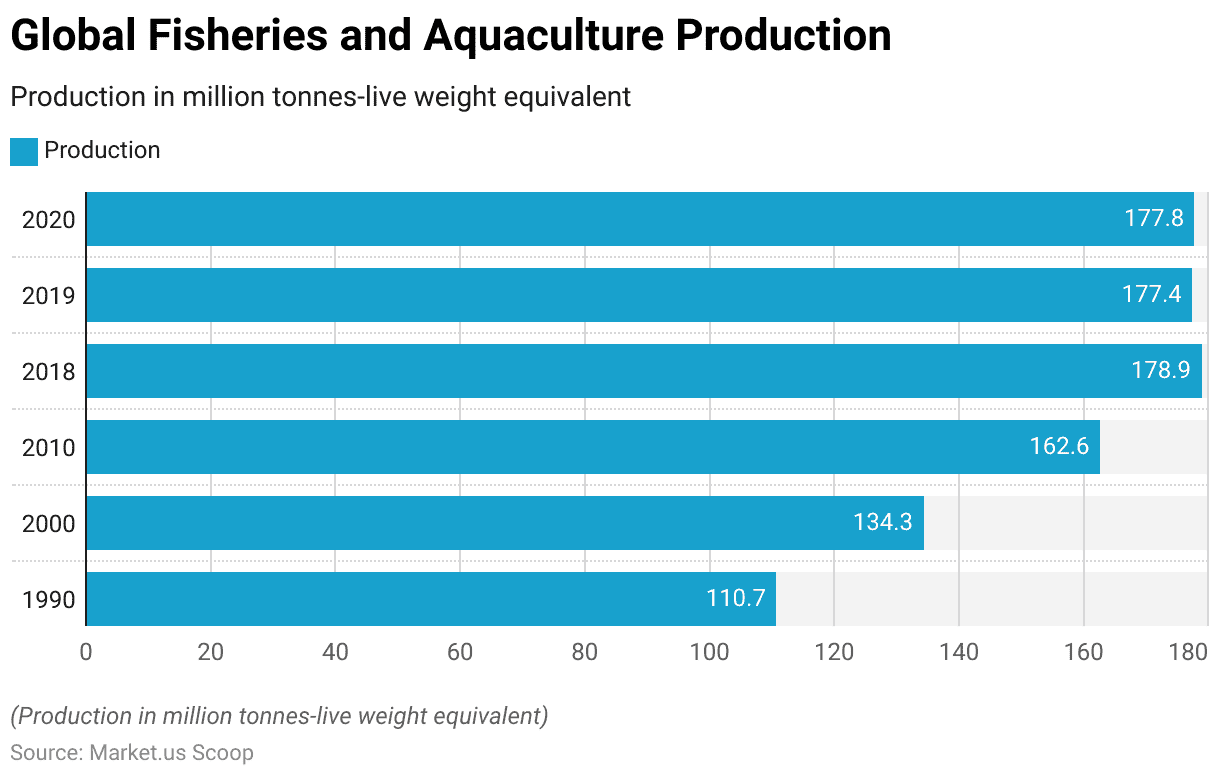
Global Fish and Seafood Consumption Statistics
Fisheries and Aquaculture Products Consumption
- Human consumption of fisheries and aquaculture products has shown a significant increase over the past decades, as measured in million tonnes-live weight equivalent.
- In 1990, the consumption was recorded at 81.6 million tonnes, rising substantially to 109.3 million tonnes by 2000.
- This upward trend continued into 2010, with consumption reaching 143.2 million tonnes.
- By 2018, consumption further increased to 156.8 million tonnes.
- The following year, 2019, saw a slight rise to 158.1 million tonnes.
- However, in 2020, there was a minor decline, with consumption dipping to 157.4 million tonnes.
- These figures underscore the growing global demand for fisheries and aquaculture products over time, alongside slight fluctuations in recent years.
(Source: Food and Agriculture Organization (FAO))
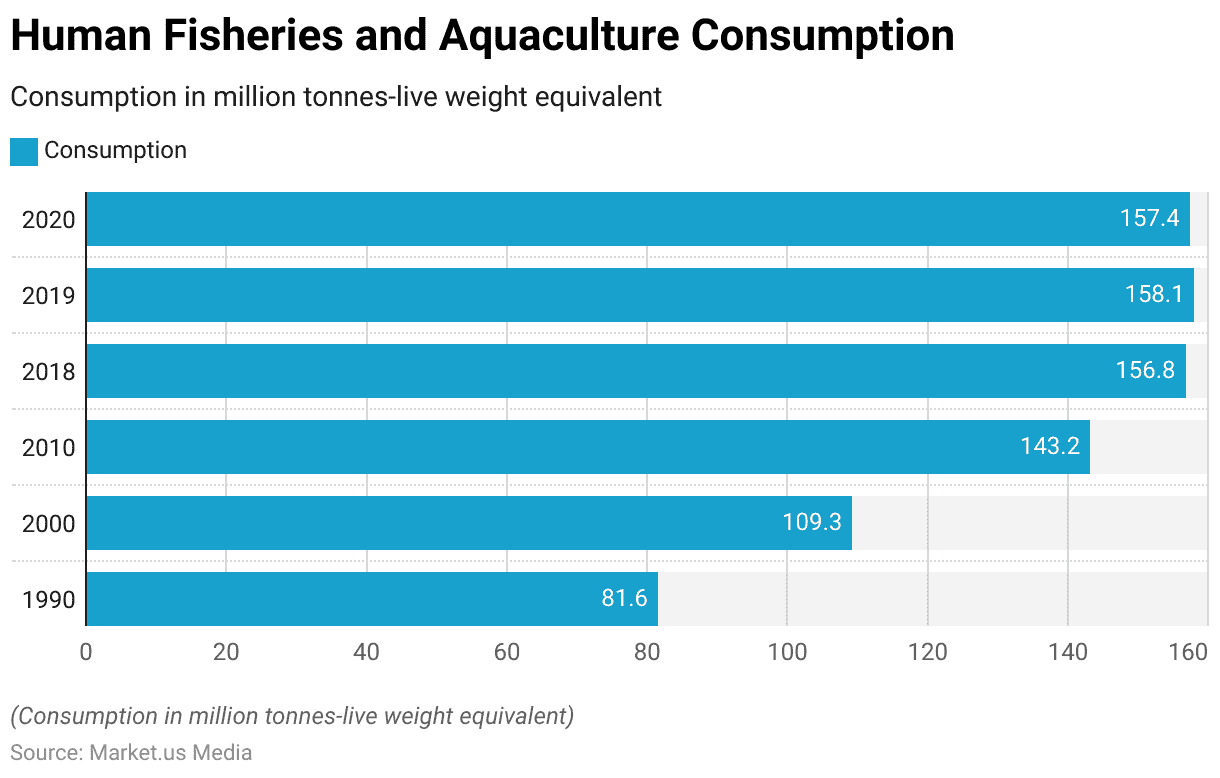
Fish and Seafood Consumption – By Country
- Fish and seafood consumption varies significantly across countries in 2024, with China leading the global market by a substantial margin.
- China consumes 57,475 tonnes of fish and seafood annually, reflecting its high demand and population size.
- Indonesia follows with 12,155 tonnes, while India consumes 11,017 tonnes.
- In the United States, fish and seafood consumption amounts to 7,544 tonnes, and Japan consumes 5,843 tonnes.
- Bangladesh’s consumption stands at 4,399 tonnes, followed by Vietnam with 3,850 tonnes.
- The Philippines consumes 3,185 tonnes, Russia 3,169 tonnes, and South Korea 2,834 tonnes.
- These figures illustrate the diverse consumption patterns across different regions, highlighting the varying levels of dependence on fish and seafood as a dietary staple.
(Source: World Population Review)
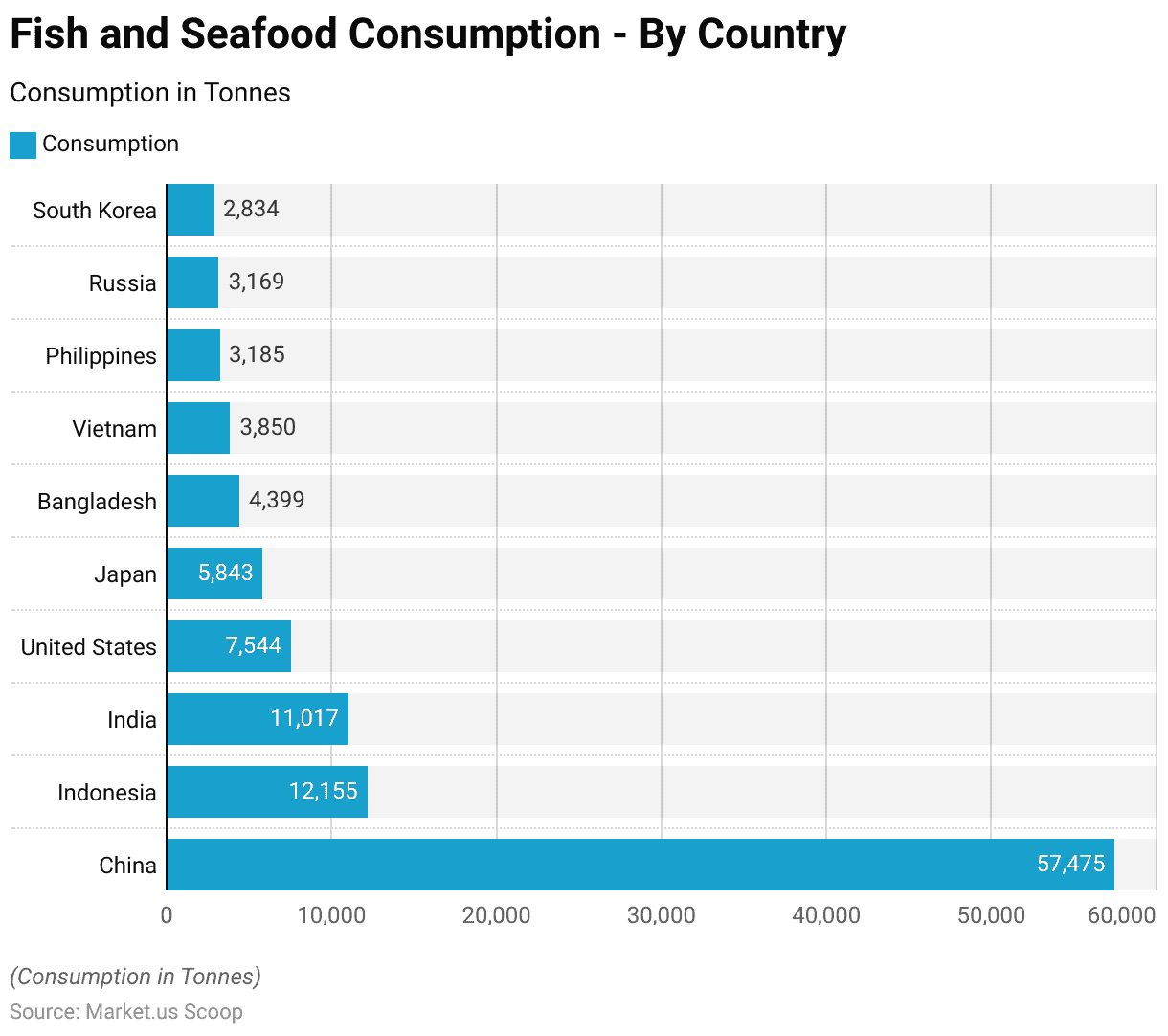
Per Capita Fish and Seafood Consumption – By Country
- In 2019, per capita fish and seafood consumption exhibited significant variation across different countries.
- Iceland led the world with a per capita consumption of 91.19 kg, followed by the Maldives at 84.58 kg.
- Portugal and South Korea showed similar levels of consumption, with 57.19 kg and 57.05 kg, respectively.
- Japan’s per capita consumption stood at 46.06 kg, while Spain’s was 42.4 kg.
- In China, each person consumed an average of 38.49 kg of fish and seafood, with France at 34.24 kg and Italy at 29.82 kg.
- Australia had a per capita consumption of 26.12 kg, and the United States 22.13 kg.
- The United Kingdom and Germany had lower consumption rates, with 18.5 kg and 12.63 kg, respectively.
- Brazil’s per capita consumption was 8.95 kg, while India and Afghanistan had the lowest figures, with 6.76 kg and 0.24 kg, respectively.
- These statistics highlight the considerable differences in fish and seafood consumption habits around the world, influenced by dietary preferences, availability, and cultural practices.
(Source: Statista)
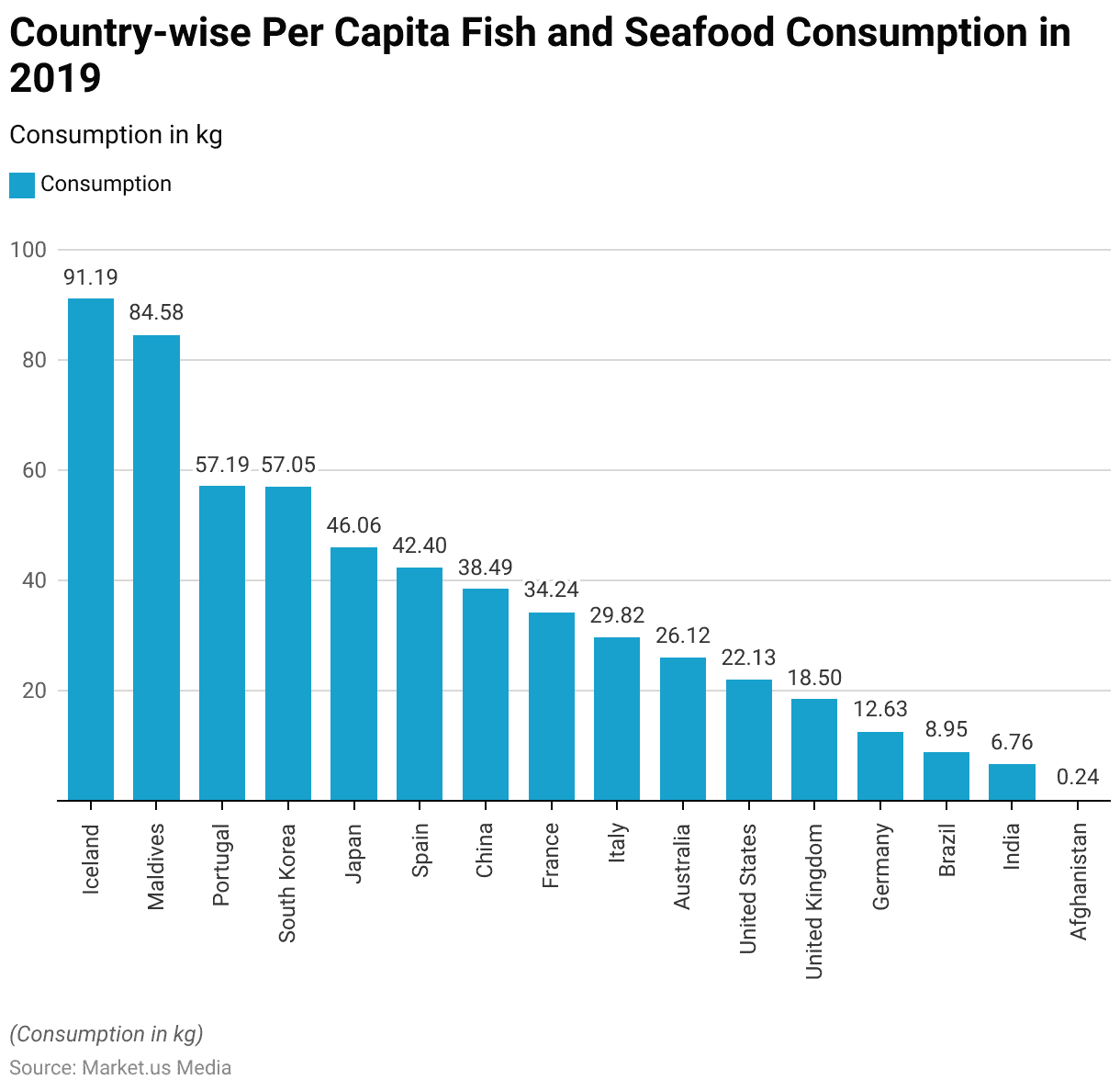
Nutrients Found in Canned Seafood Statistics
- Canned seafood is packed with various essential nutrients that offer numerous health benefits.
- For instance, a typical serving of canned sardines provides about 15 grams of protein, 229 milligrams of calcium, and significant amounts of vitamins such as B12, D, and E.
- Additionally, sardines contain 3.61 grams of omega-3 fatty acids, which are crucial for heart health.
- Canned mackerel and tuna also contribute valuable nutrients, with mackerel offering around 19.7 grams of protein and 1.17 grams of omega-3s per serving, while canned tuna is rich in protein (30.47 grams) and low in fat (3.83 grams) per 5-ounce can.
- These nutrients collectively support muscle strength, bone health, cognitive function, and cardiovascular well-being, making canned seafood a nutrient-dense option for a healthy diet.
(Sources: Nutrition Advance, Verywellfit, Livestrong)
Types of Canned Seafood Products Consumed Statistics
- In the United States, about three-quarters of the seafood consumed is either fresh or frozen, and it seems like the amount consumed in these forms has leveled off recently.
- When we break it down, more than half of what consumers are eating in this category is finfish, while the rest is mostly shellfish, especially shrimp.
- Now, when it comes to canned seafood, it makes up just under a quarter of our total seafood consumption, but here’s the kicker: its popularity has been on a downward trend for the past twenty years.
- Canned tuna used to be the king of the canned sea, representing a whopping 60% of all canned seafood consumption.
- But get this—its popularity has taken a nosedive since its peak in 1989 when folks were chowing down on 3.9 pounds per person. Nowadays, it’s a big fat zero.
- Canned shellfish comes in second, making up over 13% of the canned seafood scene, followed by sardines at 6.5%.
- Also, those smoked, salted, or pickled seafood items have been holding steady at around 2% of the total seafood consumption for the past couple of decades.
(Source: Seafood Healthfacts)
Canned Seafood Incorporated in the Diet Statistics
- Over the past twenty years, the amount of seafood (both fish and shellfish) consumed per person in the United States has fluctuated, ranging from a low of 14.6 pounds in 1997 to a peak of 16.5 pounds in 2004 and 2006.
- However, since 2004, there has been a gradual decline in annual seafood consumption, reaching 14.9 pounds per person in 2018.
- To put this in perspective, in 2016, the annual per capita consumption of other food items in the U.S. was approximately 55.4 pounds for beef, close to 90.1 pounds for chicken, over 600 pounds for dairy products, over 380 pounds for vegetables, over 250 pounds for fruits, and over 170 pounds for flour and cereal products.
(Source: Seafood Healthfacts)
Reasons to Consumer Canned Seafood Statistics
It’s a Great Source of Omega-3s
- Omega-3 fatty acids are crucial fats that your body cannot produce on its own and must be obtained from food or supplements.
- Research, including a 2019 study in International Immunology, suggests that a diet rich in omega-3s can have widespread benefits, as these healthy fats possess anti-inflammatory properties.
- They are known to improve HDL cholesterol, which aids in protecting against heart disease, as highlighted in a 2018 article in Food & Function.
- Additionally, omega-3 fatty acids contribute to joint health by alleviating inflammation, benefiting individuals with osteoarthritis, according to a 2022 review in Nutrients.
- Fish commonly found canned, such as anchovies, salmon, sardines, and tuna, are excellent sources of omega-3 fatty acids.
- According to the 2020-2025 Dietary Guidelines for Americans, it is recommended that adults consume 8 ounces of seafood per week.
(Sources: International Immunology, Food & Function, Nutrients, Dietary Guidelines for Americans)
It Lasts Longer Than Fresh or Frozen
- According to a 2018 report by the Food and Agriculture Organization of the United Nations, approximately 27% of all captured fish worldwide is discarded, mainly due to its limited freshness window.
- Canned seafood, being a cost-effective alternative to fresh fish, is preserved in airtight containers through heating or salt, extending its shelf life to years.
- This makes it a practical, nutrient-rich protein source, particularly for individuals with limited access to utilities or during travel, camping, or picnics where refrigeration is unavailable.
(Source: Food and Agriculture Organization of the United Nations)
It’s a Great Source of Vitamin D & Calcium
- Vitamin D and calcium collaborate to promote bone health. While sunlight aids your body in producing vitamin D, it’s challenging to obtain enough of this nutrient through diet alone.
- Yet, canned fish like tuna, salmon, trout, and sardines are rich sources of both calcium and vitamin D.
- For instance, according to the National Institutes of Health, 3 ounces of salmon provide around 570 IU of vitamin D, equivalent to 71% of the recommended Daily Value.
(Source: National Institutes of Health)
Consumer Preferences and Trends for Canned Seafood Statistics
Relative Importance of Each Canned Seafood Attribute
- In assessing the relative importance of various attributes of canned tuna, consumer preferences reveal a balanced prioritization among several factors.
- Packaging form emerges as the most significant attribute, with 25.49% of respondents indicating its importance.
- Close behind is the eco-label, preferred by 24.79% of consumers, reflecting growing environmental consciousness.
- Flavor is also a key consideration, valued by 24.98% of respondents, emphasizing the importance of taste in purchasing decisions.
- Price, while slightly less critical, still holds substantial weight, with 24.21% of respondents prioritizing cost.
- These insights highlight that consumers weigh packaging, environmental impact, taste, and price almost equally when selecting canned tuna.
(Source: Asian Fisheries Society)

Frequency of Choice of Canned Fish
- A recent survey on the frequency of canned fish consumption last month reveals diverse consumer habits.
- Notably, 31.85% of respondents reported not consuming canned fish at all.
- Among those who did, 13.01% consumed canned fish 1-2 times, and a significant 35.02% enjoyed it 3-4 times, indicating a moderate level of regular consumption.
- Additionally, 14.81% of respondents consumed canned fish 5-8 times, while 3.77% reported consuming it 9-12 times.
- A small yet notable 1.54% of respondents consumed canned fish 13 or more times in the past month.
- These statistics illustrate varied consumption patterns, with a substantial portion of the population engaging in moderate to frequent consumption of canned fish.
(Source: Council of Agriculture, Taiwan)

Storage Conditions for Canned Seafood Statistics
- Proper storage conditions are essential for maintaining the quality and safety of canned seafood.
- Canned seafood should be stored in a cool, dry, and dark place to prevent spoilage and preserve its nutritional value.
- The ideal storage temperature ranges between 10°C to 21°C (50°F to 70°F). It’s crucial to avoid areas with temperature fluctuations or direct sunlight, as exposure to heat can significantly increase the risk of spoilage and nutrient loss.
- Additionally, ensuring that the storage area is clean, free from pests, and well-ventilated can further protect the integrity of the canned products.
- Regularly rotating the stock by using older cans first helps in maintaining the freshness of the stored seafood.
(Sources: Pressbooks, University of Minnesota, LibreTexts, Storables)
Regulations for Canned Seafood Statistics
- Regulations for canned seafood vary by country, ensuring safety and quality standards are met globally.
- In the United States, the Food and Drug Administration (FDA) enforces stringent regulations under the Hazard Analysis and Critical Control Points (HACCP) system. This system mandates thorough analysis at each stage of production to identify and control potential hazards.
- Additionally, the FDA requires traceability, ensuring each product can be traced back through the supply chain via lot identifiers.
- In the European Union, canned seafood imports must comply with the EU’s sanitary and phytosanitary regulations, which include rigorous standards for additives, contaminants, and labeling.
- The Directorate-General for Health and Food Safety oversees these requirements, ensuring that imported seafood products meet the EU’s safety and quality standards.
- Australia also has specific certification requirements for canned seafood, including detailed labeling and health certification for various seafood products.
- The Australian Government Department of Agriculture, Water and the Environment enforces these regulations to maintain high food safety standards.
- These regulations ensure that canned seafood products are safe for consumption, protecting public health and maintaining trust in the seafood market.
(Source: FDA, European Commission, NOAA)
Recent Developments
Acquisitions:
- Bumble Bee Foods Acquires Wild Planet Foods: In March 2023, Bumble Bee Foods announced the acquisition of Wild Planet Foods, a leading producer of sustainable canned seafood. This acquisition aims to expand Bumble Bee’s product portfolio and enhance its reach to new customers.
- Thai Union’s Acquisition of American Tuna: In February 2023, Thai Union Group, one of the world’s largest seafood companies, acquired American Tuna, a leading U.S. producer of canned tuna. This acquisition is expected to strengthen Thai Union’s presence in the U.S. market.
New Product Launches:
- Karavela’s Plant-Based Canned Fish Line: In December 2021, Karavela launched a line of canned fish made from yellow peas and sustainable raw materials. This product combines traditional seafood knowledge with plant-based ingredients to cater to the growing demand for alternative proteins.
- John West’s Nutrient-Rich Tuna: In September 2021, John West introduced a new range of nutrient-rich tuna products designed to offer functional health benefits. This launch targets health-conscious consumers looking for nutritious and convenient seafood options.
- Minnow’s Inaugural Product Line: In January 2022, Minnow launched its first product line, including Alaskan salmon, Icelandic cod liver, and Spanish sardines, to increase its market share in the U.S..
Funding:
- Scout’s Seed Funding Round: In October 2022, Scout, a U.S.-based company, raised USD 4 million in seed funding to enhance its omni-channel strategy and expand operations.
- Investment in Sustainable Practices: Various companies are investing significantly in research and development to promote sustainability in the canned seafood industry. For example, Karavela invested around $3 million in R&D activities to develop its plant-based fish products.
Market Growth:
- Global Market Expansion: The growth is driven by increasing consumer demand for ready-to-eat seafood products and advancements in distribution infrastructure.
- Regional Insights: Asia-Pacific held the highest market share in 2022 due to high per capita consumption in countries like China and India. Europe and North America also have significant market shares due to their rich traditions of seafood consumption and technological advancements in food processing.
Conclusion
Canned Seafood Statistics – In conclusion, the canned seafood market is set for steady growth, propelled by consumer demand for convenient, healthy options.
Expanding beyond traditional markets, it embraces innovation and sustainability, with a focus on diverse products and eco-friendly practices.
Health and environmental awareness are driving preferences, while niche segments like premium offerings gain traction.
Despite challenges like raw material costs and regulatory hurdles, strategic approaches can ensure competitiveness.
Overall, the market presents promising opportunities for industry players who adapt to evolving consumer needs and market dynamics.
FAQs
Canned seafood encompasses a wide variety of options, including tuna, salmon, sardines, anchovies, mackerel, crab, shrimp, and clams, among others. These are preserved through canning methods to maintain freshness and extend shelf life.
Yes, canned seafood can be a nutritious choice. It typically retains its high protein content, omega-3 fatty acids, vitamins, and minerals. However, it’s essential to check labels for added ingredients like sodium and preservatives. Opting for products with minimal additives and those packed in water or natural juices can enhance their health benefits.
Canned seafood offers several advantages, including convenience, long shelf life, portability, and versatility in meal preparation. It provides a convenient protein source for quick meals and snacks, making it suitable for on-the-go lifestyles.
Canned seafood should be stored in a cool, dry place away from direct sunlight. Proper storage helps maintain product quality and extends shelf life. Once opened, any unused portion should be refrigerated in a sealed container and consumed within a few days.
Reputable canned seafood brands increasingly prioritize sustainable sourcing practices. Look for certifications like MSC (Marine Stewardship Council) or labels indicating responsible fishing methods to ensure products are ethically sourced and environmentally friendly.
Discuss your needs with our analyst
Please share your requirements with more details so our analyst can check if they can solve your problem(s)



